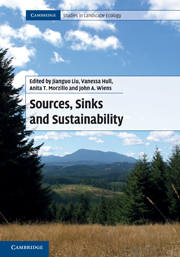Book contents
- Frontmatter
- Contents
- Contributors
- Preface
- Acknowledgments
- Part I Introduction
- Part II Advances in source–sink theory
- Part III Progress in source–sink methodology
- 9 On estimating demographic and dispersal parameters for niche and source–sink models
- 10 Source–sink status of small and large wetland fragments and growth rate of a population network
- 11 Demographic and dispersal data from anthropogenic grasslands: what should we measure?
- 12 Network analysis: a tool for studying the connectivity of source–sink systems
- 13 Sources, sinks, and model accuracy
- 14 Scale-dependence of habitat sources and sinks
- 15 Effects of experimental population removal for the spatial population ecology of the alpine butterfly, Parnassius smintheus
- Part IV Improvement of source–sink management
- Part V Synthesis
- Index
- References
13 - Sources, sinks, and model accuracy
Published online by Cambridge University Press: 05 July 2011
- Frontmatter
- Contents
- Contributors
- Preface
- Acknowledgments
- Part I Introduction
- Part II Advances in source–sink theory
- Part III Progress in source–sink methodology
- 9 On estimating demographic and dispersal parameters for niche and source–sink models
- 10 Source–sink status of small and large wetland fragments and growth rate of a population network
- 11 Demographic and dispersal data from anthropogenic grasslands: what should we measure?
- 12 Network analysis: a tool for studying the connectivity of source–sink systems
- 13 Sources, sinks, and model accuracy
- 14 Scale-dependence of habitat sources and sinks
- 15 Effects of experimental population removal for the spatial population ecology of the alpine butterfly, Parnassius smintheus
- Part IV Improvement of source–sink management
- Part V Synthesis
- Index
- References
Summary
Source–sink models are a promising empirical tool for the sustainable management of animal populations across landscapes. Recent work has demonstrated a theoretical link between the demographic processes addressed in both source–sink and metapopulation models and the formation of species’ range limits. In the face of large-scale anthropogenic disturbances (e.g., increasing temperature and sea level with global climate change), conceptual range-limit models that are functionally linked to these demographic mechanisms may help predict range shifts and provide insights for the management of vulnerable populations. However, the value of such models is limited by their ability to offer precise and testable predications about how demographic parameters might respond to environmental change and thus influence population dynamics. Here, we illustrate the gulf between the promise of conceptual demographic models and the difficulty of their empirical application by developing a model of range limits for a narrowly distributed tidal-marsh songbird, the coastal plain swamp sparrow (Melospiza georgiana nigrescens, CPSS). We first modeled a gradient in CPSS fecundity that depends on environmental factors varying with latitude. To predict the species’ range limits we embed this fecundity gradient in Pulliam’s (1988) source–sink model. Our resulting model predicts current CPSS range limits reasonably well. However, its predictions are also subject to substantial uncertainty. Our model framework generally conforms to the conceptual unification of source–sink theory, Hutchinson’s (1957) fundamental niche, and species’ range limits recently expounded by Pulliam (2000).
- Type
- Chapter
- Information
- Sources, Sinks and Sustainability , pp. 273 - 290Publisher: Cambridge University PressPrint publication year: 2011
References
- 3
- Cited by

